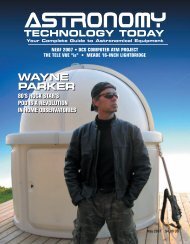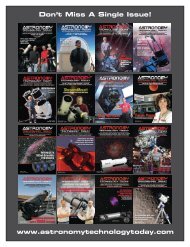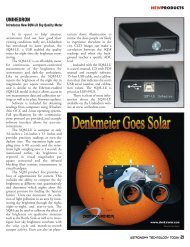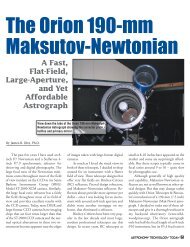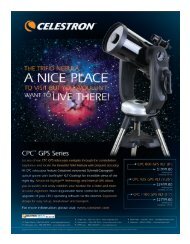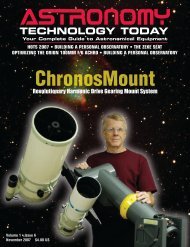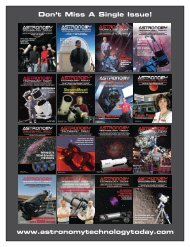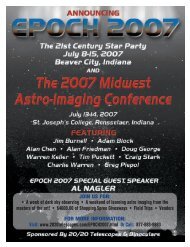A Comparative Review - Astronomy Technology Today
A Comparative Review - Astronomy Technology Today
A Comparative Review - Astronomy Technology Today
You also want an ePaper? Increase the reach of your titles
YUMPU automatically turns print PDFs into web optimized ePapers that Google loves.
TheStellarvueSV102ED:A <strong>Comparative</strong> <strong>Review</strong>By Josh WalawenderStellarvue recently released a new lowcost 4-inch ED refractor which is garneringa lot of attention. I had the chance toput one through its paces and compare itto a much more expensive doublet aporefractor to see how it stacks up. I’vealways preferred comparative reviews asthey help give a better sense of theabsolute performance of a telescopeinstead of a very cheerleading statementto the effect that “I just spent $$$ on theAcme UltraSuperScope and I love it!!!” Inthis review, I will be comparing the performanceof the Stellarvue SV102ED tothe Stellarvue SV102ABV. No review iswithout bias, of course, and I certainlyexpected (and wanted) the ABV to win inthis comparison. The ABV cost roughlytwice as much, so one would expect it tooutperform the ED.The focus of this review is the EDand the ABV serves primarily as a performancebenchmark. What I hope you’llget out of this is where the ED sits interms of both absolute performance andvalue relative to a high performanceapochromatic doublet of the same apertureand made by the same manufacturer.The SV102ED that I am testing is onloan from Stellarvue. Vic Maris ofStellarvue had been contacted by ATTabout a review and asked me to do a comparisonwith my SV102ABV. I am arepeat Stellarvue customer, but have nofinancial interest in the company. I askedVic to review the two paragraphs belowdescribing the scopes to ensure their accuracy,but other than that, any biases, omissions,or other errors are entirely my own.The PlayersThe Stellarvue SV102ED is a newtelescope introduced by Stellarvue in2007. It is a 102-mm aperture 710-mmfocal length (f/6.95) doublet which uses alow dispersion element to reduce falsecolor. The model I tested (the 102ED)has an imported dual speed Crayfordfocuser and costs $1095 new. Anothermodel (the 102ED2) which uses theFeather Touch dual speed Crayfordfocuser made by Starlight Instruments isalso available and currently retails for$1395.The reference scope is a StellarvueSV102ABV which is no longer in production.The ABV is a 102-mm f/8 doubletapo. It uses a low-dispersion primarylens element and a lanthanum secondaryelement providing excellent correction ofchromatic and other aberrations. WhileStellarvue does not advertise the ED asapochromatic, the ABV was advertised asan apo. The ABV has the additional featureof being a dual tube with a removablesection for binoviewing (hence theBV part of the moniker). In the configurationI am using (dual tube with FeatherTouch focuser), the ABV used to retail at$2195.00, almost exactly twice what theED configuration I am comparing withcosts today.Mechanics - Tube and FinishBoth scopes are clearly quality instruments,constructed with machined aluminumtubes. The ABV has a beautiful“Stardust Blue” powder coated finish<strong>Astronomy</strong> TECHNOLOGY TODAY 49
THE STELLARVUE SV102ED A COMPARATIVE REVIEWwith silver highlights (photos don’t do itjustice). The ED has a “Pearl White”powder coated finish which is still nicelooking, but lacking the silver highlightsof the Stardust Blue. Aesthetically I preferthe blue finish. Colors are a subjectivematter though and you will find otherswho would prefer the more traditionalwhite of the ED.Both scopes have very nice aluminum,threaded lens covers which are avast improvement over push on caps.This won’t fall off at inopportune timesand will protect your lens against almostany conceivable abuse while in place. Forsuch a minor feature, I really appreciatethese caps; they exude a sense of qualityand attention to detail.Both scopes come with sliding dewshields; the ABV's is a bit larger and usesa lock screw to secure the shield in place.The ED’s dew shield is a bit smaller indiameter, making for a lighter weightscope. It also lacks the lock screw of theABV, but is a tighter fit. The motion isstiffer in the ED, but is very solid with nodroop or sag at all. The dew shield staysin place even through significant temperaturechanges. Given the slightly moresvelte look of the ED dew shield and itsideal slide-it-out-and-forget-it behavior, Iactually prefer the dew shield of the EDto the ABV. Stellarvue provides instructionson adjusting the stiffness of theirdew shields by adding small bits of felt, sothat it can be adjusted to taste. I did notfind that necessary on either scope.Clamshell vs. RingsThe ED comes with a machined aluminumclamshell to hold the scope (traditionalheavy duty rings are also available).The clamshell has a short 2-inchwide, Vixen-style dovetail built in andone can easily attach a 3-inch wide,Losmandy-style dovetail to the bottom ofthat. The scope is held securely by theclamshell, though those interested inastrophotography might prefer ringswhich can be spaced further apart forenhanced stability and for their largersurface area at the top for mounting largeaccessories such as a guide scope or a piggybackedcamera. The clamshell is smallerand behaves like an integral part of thescope; it will slip more easily into casesthan the rings.FocusersThe ED has a dual-speed Crayfordfocuser while my ABV uses a 2-inchFeather Touch made by StarlightInstruments. The ED’s focuser is a stepdown from the Feather Touch (butalmost every other focuser is as well). Myfirst night out with the ED, I immediatelyput a 2-inch diagonal and 31-mmNagler eyepiece in. This combinationrequired a quick tensioning adjustmentbefore the ED’s focuser would lift all thatmass. With that tension, the focuser felt abit tight on the coarse focus knob. I alsoWorld Leaders In Observatory Dome ManufacturingDomes from 2.9m - 6.5m in diameter, delivery worldwide direct to you.Kit Metal Dome Coming Soon ◆ Economical For ShippingWe are excited to announce that Pier-Tech is our new U.S. Distributor!For more information go to www.pier-tech.com,email sales@pier-tech.com or call 630-841-6848.http://www.astrodomes.com astrodomes@astrodomes.comMt Stromlo 4.5 Astro DomesKit Metal Dome50 <strong>Astronomy</strong> TECHNOLOGY TODAY
THE STELLARVUE SV102ED A COMPARATIVE REVIEWnoticed that the coarse focus always felt abit rough regardless of the tension. Thefine focus was smooth and easy to useeven with the tension tightened. In comparison,the Feather Touch is butterysmooth and I’ve never needed to adjustthe tension on it regardless of temperatureor load.Focusing at high powers was easierwith the Feather Touch, but the ED’sdual-speed Crayford was a huge step upover other single-speed Crayfords I’veused - both imports and high end models.Unless you’ve already been spoiled byusing the Feather Touch (or other comparablefocuser) on another scope, youwill probably find the ED’s focuser morethan satisfying for visual use. As for me,even though the ED’s focuser performsadequately, I’d opt for the Feather Touchoption on the ED (or on any scope forthat matter). You won’t regret it.The ED’s focuser (either the basefocuser or the Feather Touch) is rotatablewith a collet style locking system whichensures that the focuser remains alignedto the optical axis. Don’t underestimatethe importance of maintaining the alignmentof the focuser. You’re paying for atelescope that has been tested and properlyaligned; you don’t want to lose that.The collet works well, though I mustadmit that I didn’t use it much. My ABVdoes not have a rotating focuser, so I’mused to simply rotating the diagonal andthat’s what I did.PortabilityThe ED can be made airline carryonsize by unthreading the focuser from thetube. The threads are very fine and precisionmachined to maintain alignment. Iflew from the Astro Imaging Conferencein California back to Hawaii with thescope and had no problems. There aretwo optional cases available, one for airlinecarryon and one longer case. I wouldrecommend getting the longer case forthe ED unless you plan on flying a lot. Ifyou save the step of unthreading andstowing the focuser each night, it savestime during setup and take down.Testing SetupMost of the testing was performedwith the scopes mounted side-by-side ona Losmandy G-11 mount. Most testingoccurred during four observing sessionslike that pictured at the VisitorInformation Station (VIS) on Mauna Keaon the Big Island of Hawaii at about9,000 feet above sea level. I also spenttwo nights with the ED riding solo onthe G-11 while observing from MaunaLoa (at 11,100 feet, see photo on page49). The G-11 carried the two scopeswell and I could run at high powers withnegligible image shake.I live in Hilo near sea level, so foreach observing run the scopes were transportedfrom warm humid conditions(roughly 70 degrees F and 60-70%humidity) to cold, dry conditions at altitude(usually 30-40 degrees F and
THE STELLARVUE SV102ED A COMPARATIVE REVIEWthe Airy disk and the minimum amountinto the surrounding diffraction rings.(See “A Closer Look at HighMagnification” by Gordon, R.W. in TheBest of Amateur Telescope MakingJournal Vol. 1 pg. 229. ed. Cook, W. J.pub. Willmann-Bell or Telescope OpticsA Comprehensive Manual for AmateurAstronomers by Rutten, H. and vanVenrooij, M. pg. 218 pub. Willmann-Bell) Those diffraction rings have theeffect of moving light from one area ofthe image into a neighboring area. Thisreduces contrast, for example betweenthe ice caps and dark markings on thesurface of Mars. I sometimes find thatpeople respond immediately to differencesin brightness between two scopes(i.e. of different apertures), but look pastthe contrast transfer of the optical systemwhich is also a component of seeing finedetail in extended objects be they planetarysurfaces or nebulae. Seeing the contrastbetween the dark nebulae aroundthe Swan Nebula and the surroundingsky is what originally sold me on myABV refractor.Bright StarsThe ED shows a modest violet haloaround bright objects, but it is a verydeep violet color, not the bright blue thatis thrown up by inexpensive achromats. Ihaven't done a side-by-side with the followingscopes, but to my memory, thehalo is substantially fainter and deeperviolet than all of the following scopes thatI have looked through: a 152-mm f/8inexpensive achromat, a Stellarvue 80-mm f/6 AT1010 achromat (aka theNighthawk), and a Stellarvue 80-mmf/9.4 SV80/9D achromat. The diffractionrings are well defined in the ED andthe scope appears well collimated.The ABV shows truly color free starsin focus, with the only color visible in theout of focus images. The ABV wouldappear to meet any reasonable definitionof apochromat over the wavelength sensitivityof my dark adapted eye. It alsoshows nicely symmetric diffraction ringsindicating good alignment.For all high power observations (ofbright stars, the moon, and double stars),I was able to start the comparison by dialingin almost exactly 200x in both scopesusing a 2-4-mm Nagler zoom eyepiece (at3.5 mm in the ED and 4 mm in theABV). At 200x the views were nearlyindistinguishable aside from the presenceof the faint violet halo on bright objectsin the ED.The MoonThe ED images are nice and sharp,but the violet fringe around the edge ofthe moon is, of course, visible. Whencompared with the ABV, it was clear thatthe dark shadows behind mountains or incraters were slightly bluish in the ED dueto the slight chromatic aberration. As aresult, the ABV appears more contrastywith nice deep, dark, black lunar shadows.This is a subtle effect however andanother observer with me did not noticeit until I described it to him.Beware which eyepieces you use toevaluate color correction in refractors.When using some wide-field units, I initiallysaw more color on the limb of themoon, but that went away when the limbwas centered in the eyepiece field of viewindicating that it stemmed from lateralcolor in the eyepiece and not the objective.Double & Multiple StarsI spent a couple nights hunting downmultiple stars with both scopes. There wasnever a pair which could be split in onescope, but not the other, so the sharpnessof these scopes appears very similar. Onthe very closest doubles, the views in theABV showed a black separation betweenthe two stars a bit more often than theED, I suspect that this is due in part tothe small amount of chromatic aberrationon the ED lessening the contrast of thatgap. These differences were only visible athigh magnifications, those at the higherpower settings on the 2-4-mm Naglerzoom (roughly 250-400x), so both scopeswere performing well beyond the 50x perinch rule of thumb that is often put forwardas a reasonable expectation for agiven size scope.On color contrast doubles, if thecompanion was a faint blue star, it wasbrighter and more vivid in the ABV, makingdetection easier and giving a morepleasing visual appearance and colorcontrast.52 <strong>Astronomy</strong> TECHNOLOGY TODAY
THE STELLARVUE SV102ED A COMPARATIVE REVIEWPlanetsI examined Mars when it was high inthe sky under good seeing conditions. TheABV showed a bit more contrast on darksurface markings, but that was subtle.When I saw something in the ABV, Icould always switch to the ED and findthe same feature, even if it was a bit lesscontrasty. With both scopes, I tried a rangeof magnifications using the 2-4-mm zoomand usually found that although the seeingsupported high magnification, the bestviews of low-contrast details were at moremodest powers (around 200-250x, ratherthan 300-400x).I took a look at Saturn one morningand found essentially the same results aswith Mars as far as the contrast apparentin both scopes (edge to the ABV). UnlikeMars, Saturn supported the highermagnifications since its features arehigher contrast. I spent most of my timeon Saturn at the 2.5-mm setting on thezoom (280x on the ED and 320x onthe ABV).Deep Sky ObjectsI viewed a range of deep sky objectsincluding the bright showpieces of M42,M81, and M82, but also examined bothscopes’ performance on fainter objectssuch as M78. Observations at high powerswere easier to compare between thetwo scopes since I could begin by dialingin 200x on both scopes to get a goodbaseline comparison. This wasn’t possibleat moderate to low powers with my eyepieceselection, so detailed comparisonson deep sky objects were more difficult. Iended up doing most of the comparisonsby switching the same eyepiece back andforth between the two scopes. I usedPentax XWs between 5 mm and 20 mm.Aside from the obvious difference inmagnifications (about 14% more in theABV) the views were indistinguishable.When there was a slight noticeable differencein the views it was probably attributableto the magnification differencerather than scope performance. The preferencealways went to the view at slightlyAll images are 7 second, single, unprocessed frames taken by Jack Huerkampwith a HyperStar-Equipped Celestron CPC1100.Sole Authorized U.S. DistributorMallinCam Video CCD Observational SystemTaking Video <strong>Astronomy</strong> to the Next Level!The MallinCam HYPER PLUS• B&W or Color • Internal Mild Peltier Cooler• High QE Class 1 CCD Sensor • Reliable HandAssembled Quality • Upgradeable • NotDisposable • Dual Video Outputs • 1/12,000th to 56Seconds • Integrated On Screen Menu ContainingAn Extensive List of Video Output EnhancementFeatures • In Production • No Long Delays985-863-2165 • www.WaningMoonII.com<strong>Astronomy</strong> TECHNOLOGY TODAY 53
THE STELLARVUE SV102ED A COMPARATIVE REVIEWhigher power whether with the same eyepiece(advantage ABV) or with a shorterfocal length eyepiece in the ED to compensatefor its shorter focal length(advantage to the ED).Get Yours<strong>Today</strong>!ScopeBuggyMAKING VIEWING EASIER!• For use with most tripods, DOBs and piers• Load tested to 600+ pounds• Assemble in minutes for use or storage• Pneumatic inflated 10” tires for soft ride• Gloss Black powder coat paint• Optional battery equipment tray• Adjustable rear axle height, 1 1/2” to 7”• Anodized gold wheels• One person can move any size scopequickly and easily• Ideal for the new Meade RCX Series• Ideal for the Meade LightBridge Series• Ideal for scopes up to 36”SCOPEBUGGYP. O. Box 834Elephant Butte, NM 87935Toll Free: 866-312-8449Let us custom build youthe best, strongest, mostwell constructed scopetransport case available!www.scopeguard.comPlus S&H, Approx.$30 Shipping USAShipping weight 36 lbs.shipped UPS groundPatent PendingPlease visit us atwww.scopebuggy.comWE ACCEPT: VISA – MASTERCARD – AMERICAN EXPRESSPAYPAL – MONEY ORDERS – CASHIERS CHECKSSummaryBeing familiar with Stellarvue’s reputation,I was expecting the SV102ED toperform well. I thought it would fit nicelyin the gap between the 80-mm achromatsI’d used and the 102-mm true apoABV (which is also where it falls in termsof price). I was surprised to see, however,that its performance was much closer tothe apo than to the achromats. The ABVis a spectacular performer. I’ve comparedit to another high end apo doublet whichuses a more conventional secondary elementand the ABV had a slight edge.Given that, I expected the ED to fallbehind quickly, but it didn’t.Yes, the ED shows a noticeable bluehalo around bright objects, but it is adeeper blue or violet than traditionalachromats. At high powers, in excess of50x per inch, this led to somewhatdecreased contrast in the ED, the sharpnesswas nearly equal, but there werehints in good seeing that the ABV mayhave had a very slight edge in sharpness.For many observers this will be anegligible effect and not worth payingsubstantially more for the true apoperformance.The Stellarvue SV102ED is an excellentchoice for someone looking for a reasonablypriced, high performance 4-inchrefractor. The optical performance isexcellent and the mechanics are bothfunctional and aesthetically pleasing.Given Stellarvue’s reputation for goodquality control, I would expect very consistentperformance from all SV102EDscopes. It is portable and cools downquickly, and thus would make a good firsttelescope that will not be outgrown. Itwill also nicely complement a large lightbucket and so should appeal to beginnersand experienced observers alike.54 <strong>Astronomy</strong> TECHNOLOGY TODAY
THE STELLARVUE SV102ED A COMPARATIVE REVIEWSV102ED SPECIFICATIONSThe standard SV102ED incorporates an f/6.95 ED doubletobjective and collet system for a fully rotating 2-inch dualspeed Crayford style focuser. It is also supplied with a red dotfinder and Stellarvue's best CNC clamshell mounting ring, allfor $1095.00.The deluxe version, the SV102ED2 is identical to thestandard SV102ED, but is equipped with a dual speed FeatherTouch focuser and priced at $1395.00.Stellarvue now offers a photographic field flattener/focalreducer system that increases the speed of the SV102ED tof/5.6 and flattens the field for optimum use with film or CCDimaging. The field flattener/focal reducer system is comprisedof three parts including the Tele Vue RFL-4087 reducer/flattener,the RAD-1074 2-inch insert tube and the TRG-1072 T-ring adapter. Stellarvue offers other adapters for systems thatdo not use a T-ring. The price for this field flattener/focalreducer system is $405.00.Stellarvue offers an aluminum hard-side, foam-lined casethat will accept the fully assembled SV102ED withoutremoval of the focuser. This case has exterior dimensions of10 inches by 10 inches by 32.5 inches and is priced at only$99.00 (Item #C12).Stellarvue also offers an airline carry-on aluminum hardside,foam-lined case that accepts the SV102ED with thefocuser removed. This case has exterior dimensions of 9 inchesby 14 inches by 22 inches and is priced at $85.00 (Item#C102).A third option for storage and transport of the SV102EDis Stellarvue's soft side, padded case which has exterior dimensionsof 9 inches by 14.5 inches by 24 inches. The case alsoaccepts the SV102ED with focuser removed and is priced at$99.00 (Item #C8).Stellarvue SV102ED2 on M7 mount with StellarvueD1029ED diagonal and Televue Nagler 20 eyepiece.Background image is NGC 253 taken by Jon Talbot with theSv102ED2 on an MI-250 mount.<strong>Astronomy</strong> TECHNOLOGY TODAY 55



